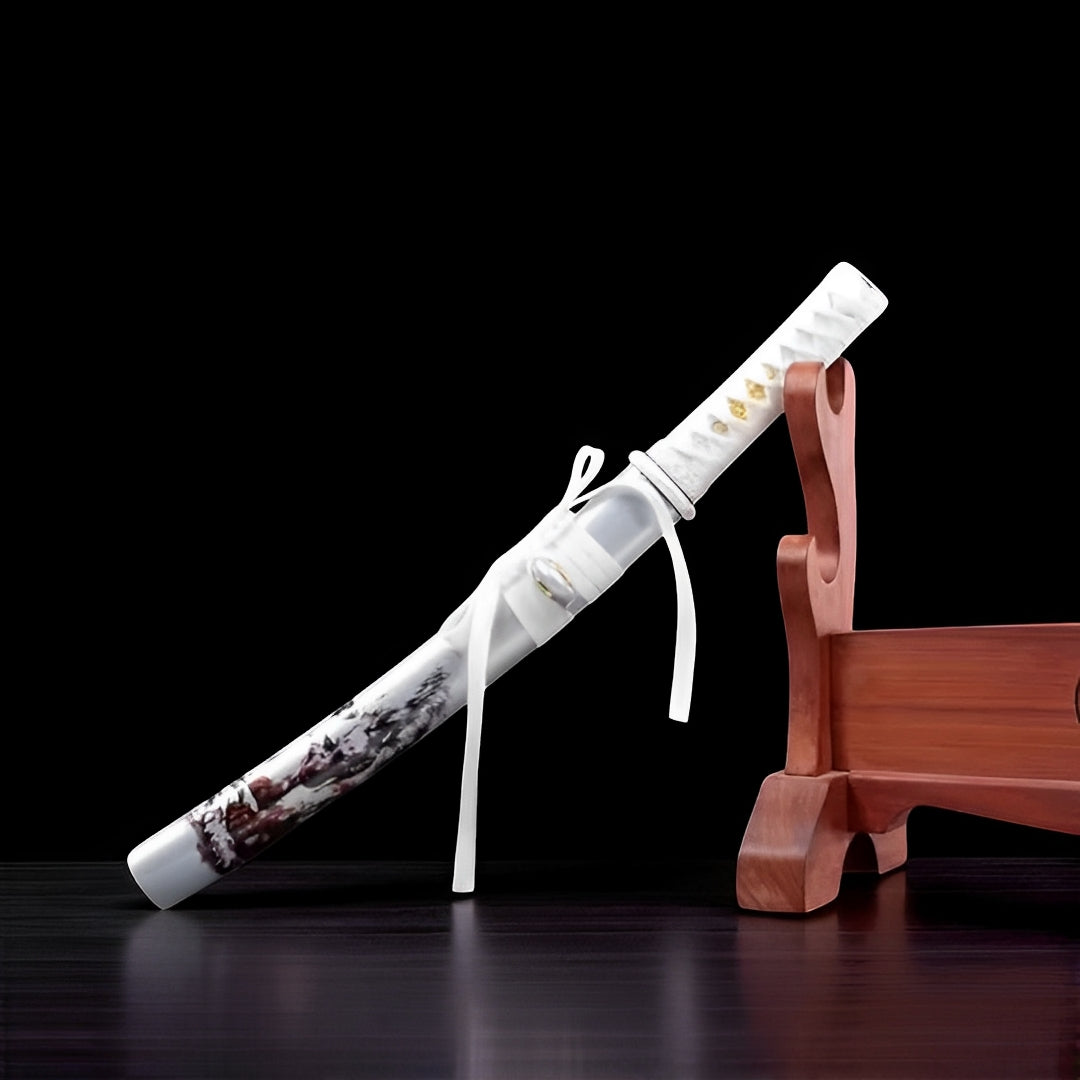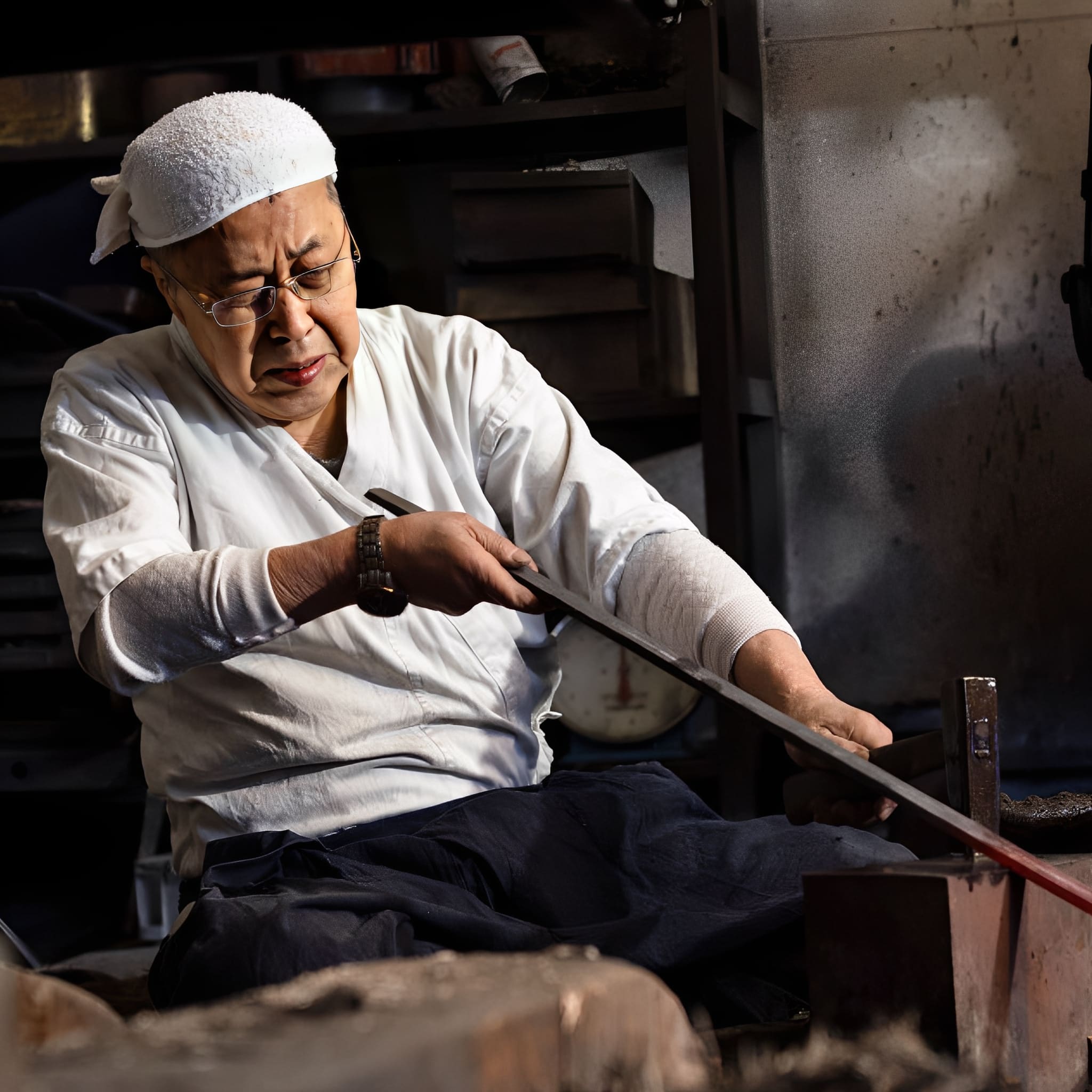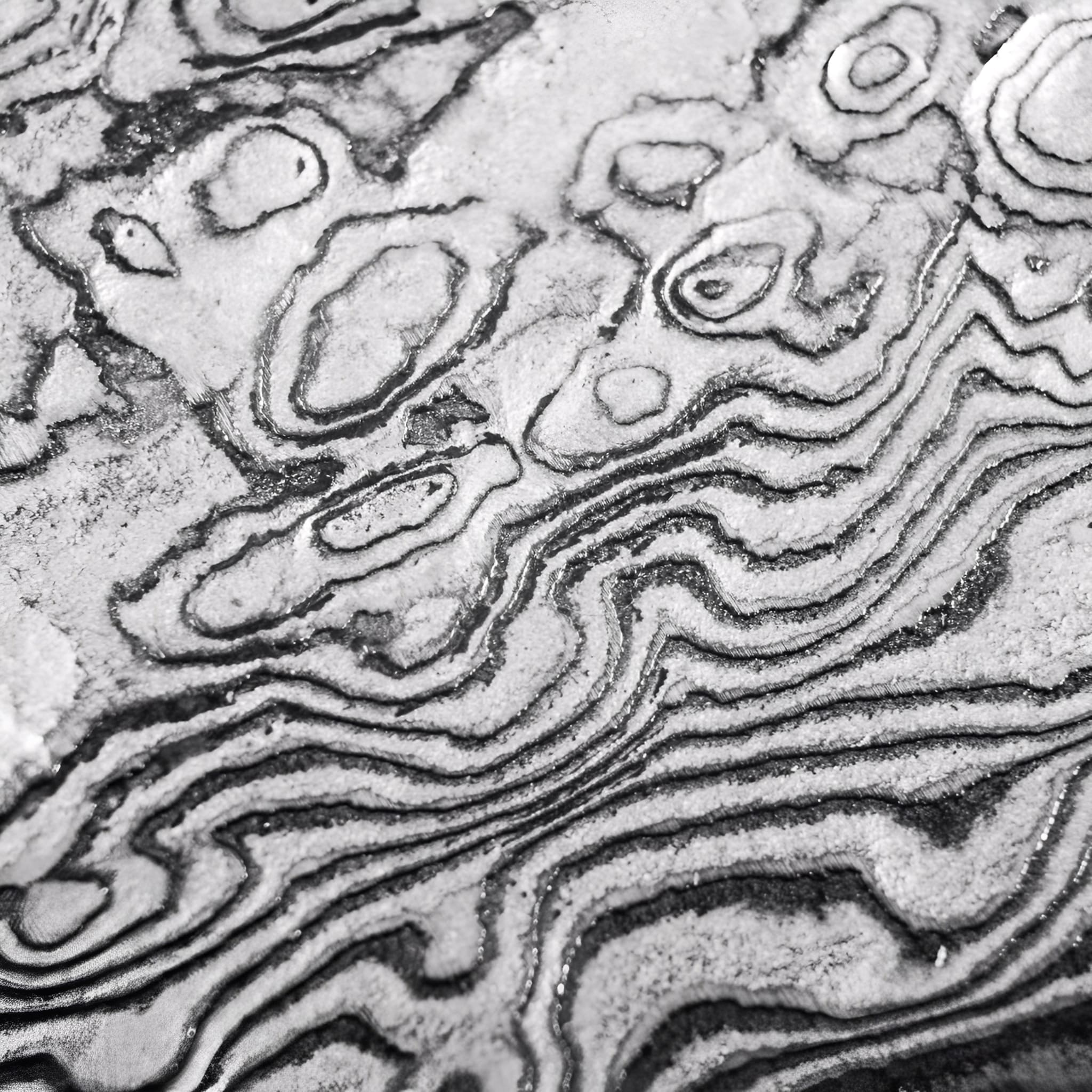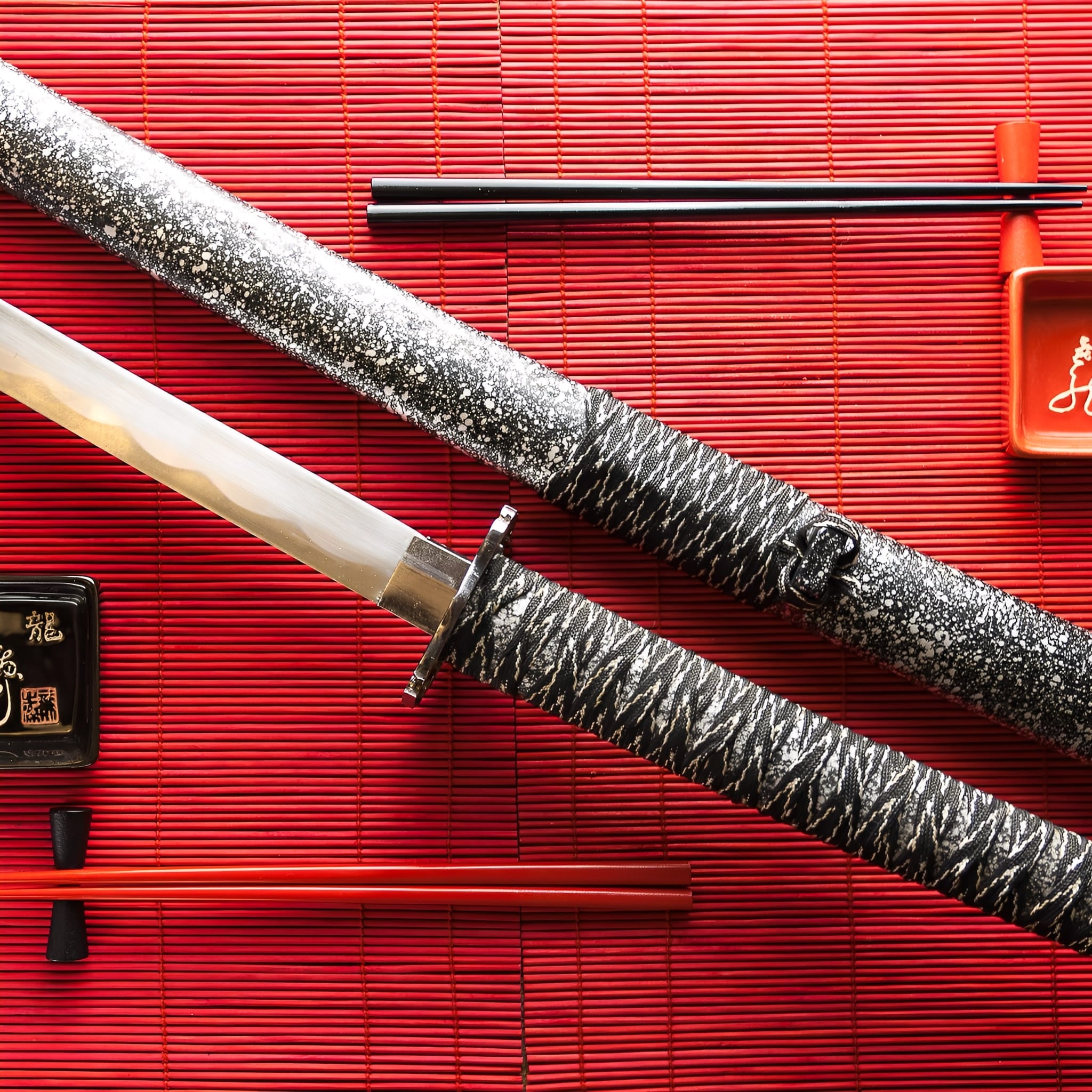Refund Guaranteed

Why choose us
Ships within 48/72h
Forged Blade
Collector Quality
Trusted Globally
Inspired by Japan
Shirayuki Tanto (T10 Steel) - 白雪短
Popular upgrades
Free Shipping over $250
No Bots, No AI
Refund Guaranteed
Free Shipping over $250
No Bots, No AI
Our team is here to help with any questions or concerns.
We’re always happy to assist you — don’t hesitate to reach out.
Why choose us
Ships within 48/72h
Forged Blade
Collector Quality
Trusted Globally
Inspired by Japan

Shirayuki Tanto (T10 Steel) - 白雪短
Specifications
- Handcrafted
- SHARP blade
- Blade: Blue T10 steel
- Habaki made of brass
- Synthetic ray skin on the tsuka
- Iron tsuba
- White silk ITO wrapping
- Solid wood saya with silver wolf print
- Black silk sageo cord
- Kojiri, Fuchi & Kashira made of iron
- Full tang in the handle
- Total length: 50 cm
- Blade length: 33 cm
- Blade width: 3.2 cm
- Blade thickness: 0.7 cm
-
Handle length: 16 cm
Shirayuki Tanto - Snow White Canvas Blade
Experience purity refined to lethal edge with the Shirayuki Tanto, where pristine white surfaces meet flowing ink artistry. This meditative Japanese short sword transforms traditional weapon into canvas - delicate sumi-e brushwork dances across snow-white saya like calligraphy on winter morning, creating visual poetry that asks whether you're collecting blade or acquiring scroll. For those who understand that greatest violence can wear most peaceful face.
Ink on Snow Philosophy
The name Shirayuki (白雪 - white snow) captures this tanto's essential character: absolute purity interrupted by deliberate marks. The brilliant white saya provides virgin canvas rarely seen in traditional weaponry, where blacks, browns, and natural woods dominate. This color choice makes bold statement - white shows every flaw, accepts no compromise, demands perfection in execution.
Against this immaculate backdrop, black ink illustrations flow with sumi-e painting technique's characteristic spontaneity. The artwork appears to depict traditional Japanese scenes - possibly warriors in combat, landscapes with mountains and waves, or mythological creatures. The monochromatic approach honors centuries of Japanese ink painting where masters demonstrated that single color contains infinite tonal variation.
Sumi-e (墨絵 - ink painting) represents one of Japanese culture's highest art forms. Practitioners spend lifetimes learning to control brush pressure, ink density, and hand speed to create marks that capture essence rather than detail. Applying this meditative technique to decorative tanto saya elevates weapon into cultural artifact.
The ink work shows deliberate restraint - images concentrate on portions of the white surface, leaving generous negative space that prevents visual crowding. This understanding of ma (間 - meaningful emptiness) demonstrates sophisticated aesthetic sensibility where absence matters as much as presence.
Gold accent details punctuate the monochrome composition - small metallic elements that catch light like sun glinting off fresh snow. These strategic touches prevent the black-and-white from becoming stark, adding warmth without compromising the overall cool palette.
White as Statement
Traditional Japanese weapons rarely feature white prominently - practical concerns about dirt visibility and symbolic associations with death and mourning made craftsmen cautious. But certain periods embraced white for ceremonial tanto, recognizing that purity's visual power outweighed maintenance challenges.
This white tanto requires owner commitment. Unlike forgiving black scabbards hiding fingerprints and dust, white surfaces reveal every contact. This demanding nature filters casual collectors from serious curators who approach their pieces with appropriate reverence and care protocols.
The pristine presentation suggests ceremonial function rather than battlefield utility. Historical samurai owned multiple tanto - workhorse blades for daily carry and precious examples for formal occasions. The Shirayuki clearly belongs to the latter category, designed for moments when appearance communicates as powerfully as the steel within.
White also symbolizes new beginnings, fresh starts, unmarked potential in Japanese culture. A white tanto suggests readiness to write new stories, its surface awaiting the metaphorical ink of future adventures and memories.
The cream-white ito handle wrapping maintains color consistency while traditional diamond pattern provides textural interest and functional grip. Brass fittings offer warm metallic contrast - their golden tones complementing rather than competing with the monochrome saya artwork.
Zen Minimalism in Steel
This artistic tanto embodies wabi-sabi aesthetic principles - finding beauty in simplicity, accepting imperfection as authenticity's proof, recognizing that emptiness contains potential. The white saya with sparse ink work achieves visual impact through what it doesn't show as much as what it reveals.
Zen philosophy teaches that greatest truths require fewest words. Similarly, the Shirayuki's restrained decoration communicates more powerfully than busy ornamentation ever could. Each brushstroke earns its place through necessity rather than filling space from decorative obligation.
The design invites contemplation rather than immediate consumption. Unlike bold multicolor tanto demanding instant attention, the Shirayuki rewards patient observation - viewers must approach closely, study the ink work's nuances, appreciate the negative space's compositional role.
This contemplative quality makes the tanto ideal for traditional tokonoma alcove display where single carefully chosen object receives focused appreciation. The white surface reflects and amplifies available light, creating subtle luminosity that changes throughout the day as sun angles shift.
Collector's Canvas
This minimalist tanto attracts specific collector sensibilities - those who gravitate toward Japanese ink painting, appreciate negative space in composition, value restraint over excess, or seek weapons transcending pure functionality to enter artistic territory.
Display considerations matter intensely with white pieces. Background colors dramatically affect perception - against dark walls the Shirayuki floats luminously, while lighter backgrounds create subtle tonal conversations. Glass cases with controlled lighting prevent yellowing while allowing the white's purity to shine.
Perfect for collectors specializing in artistic Japanese weapons, interior designers curating spaces where Eastern philosophy influences aesthetic choices, martial arts practitioners who view weapons as meditation objects, or anyone building collections where each piece must justify its presence through uniqueness.
The Shirayuki particularly appeals to those who own multiple tanto and seek pieces offering maximum contrast to darker examples. In varied collections, this white canvas provides essential visual relief while demonstrating the owner's appreciation for aesthetic diversity.
Museums and serious private collections often include at least one white-mounted weapon to showcase the full range of traditional finishing options and demonstrate that Japanese bladesmiths considered every possible aesthetic approach.
Care Instructions: Handle exclusively with clean hands or cotton gloves - oils and dirt show immediately on white surfaces. Store in protective cloth bags when not displayed. Clean gently with appropriate products for white lacquer or paint. Avoid direct sunlight which yellows white finishes over time. The demanding maintenance becomes ritual that connects owner to piece through attentive care.
Purity requires courage. The Shirayuki Tanto rewards those who meet its standards.
Legal Disclaimer
By purchasing from Katana Corp, you acknowledge and agree that:
- You are at least 18 years of age (or the age of majority in your jurisdiction).
- You are solely responsible for verifying and complying with all local laws and import regulations before placing an order.
- Some countries prohibit the importation of swords entirely. Katana Corp is not responsible for orders delayed, seized, or refused by customs authorities.
- All katanas and related products are sold strictly as decorative and display items. They are not intended or certified for combat use.
- Depending on the jurisdiction, swords may legally be considered bladed weapons, subject to specific restrictions or prohibitions.
- Katana Corp disclaims all liability for any injury, damage, or legal consequences resulting from misuse, abuse, or unlawful use of its products.
For full details, please refer to our Terms of Service.
Care & Maintenance
To maintain your katana's appearance and performance over time, we recommend:
- Regularly wiping the blade with a soft cloth to remove fingerprints and moisture.
- Applying a light coat of choji oil to prevent rust (for carbon steel blades).
- Storing the sword in a dry place, preferably inside its saya.
- Avoiding direct contact with hard surfaces to preserve sharpness and finish.
For more care tips, check our full maintenance guide in the FAQ section.
Behind the Blade
Every katana we offer carries the essence of centuries-old craftsmanship.
More than just a weapon, the katana symbolizes discipline, honor, and mastery.
Our artisans draw inspiration from traditional forging methods to ensure each blade reflects the spirit of the samurai — strength, precision, and soul.
Owning one is not just about aesthetics — it’s about carrying a piece of that legacy.
User Experience
This katana is designed to offer a perfect balance between blade and handle.
Its ergonomic tsuka (handle) allows a secure two-handed grip, while the weight distribution ensures smooth, fluid movement.
Whether for training, display or cutting practice, handling feels natural and precise.

The Art of Traditional Forging
Each katana we craft is born from centuries of samurai tradition.
Our master smiths shape every blade by hand, folding the steel to achieve unmatched strength, flexibility, and beauty.
This time-honored process is not just about creating a weapon? it’s about preserving a legacy of discipline, honor, and artistry.

Materials Chosen Without Compromise
We select only the highest-grade steels and authentic fittings to ensure every katana is both a masterpiece and a reliable companion.
From the flawless hamon line to the perfectly balanced tang, each detail is carefully inspected to meet the highest standards of performance and aesthetics.

More Than a Sword, A Lifelong Legacy
Owning a handmade katana is an experience that goes beyond the blade itself. It’s holding history, tradition, and craftsmanship in your hands.
Whether displayed as a work of art or wielded with precision, your katana will stand as a symbol of timeless skill and dedication for generations to come.
-
Key Destinations
United States: 5–7 days
Canada: 5–7 days
Australia: 6–9 days
Denmark: 4–6 days
Netherlands: 3–5 days
Sweden: 4–6 days
Switzerland: 3–5 days
Finland: 5–7 days
Singapore: 6–8 days -
Central European Partners
France: 2–3 days
Germany: 3–5 days
Spain: 4–6 days
Italy: 4–6 days
Belgium: 3–5 days
Austria: 4–6 days
Ireland: 4–6 days
Poland: 4–6 days
Portugal: 4–6 days -
Extended EU Network
Czechia: 4–6 days
Hungary: 4–6 days
Slovakia: 4–6 days
Slovenia: 5–7 days
Romania: 5–7 days
Bulgaria: 5–7 days
Croatia: 5–7 days
Serbia: 5–7 days
Estonia: 5–7 days
Latvia: 5–7 days
Lithuania: 5–7 days
Luxembourg: 3–5 days
Greece: 5–8 days -
FAQ’s
Visit our FAQs page to find answers to common questions.